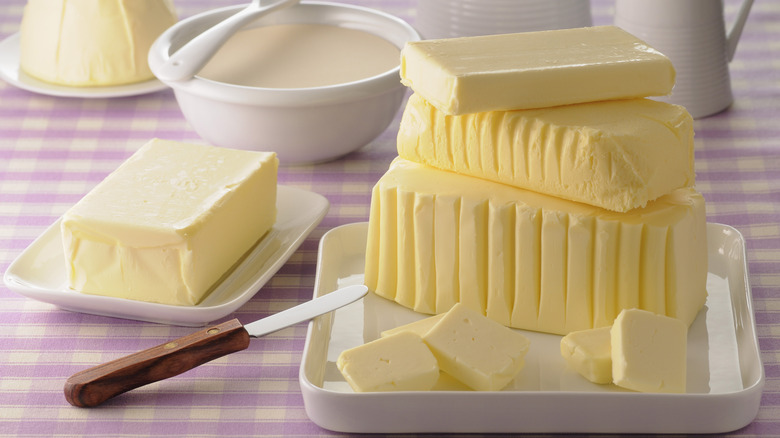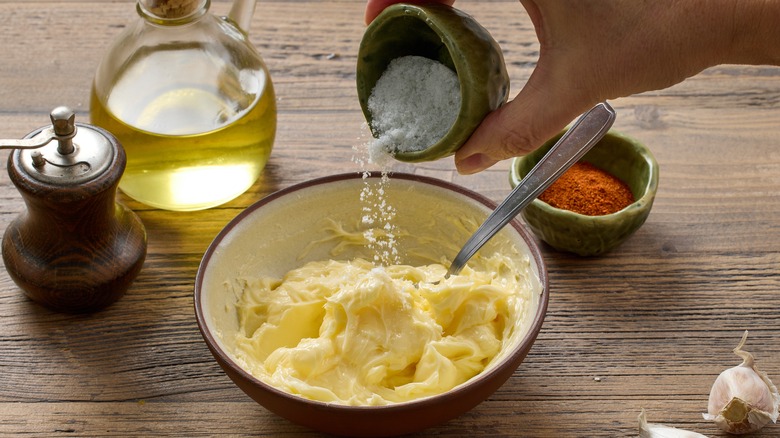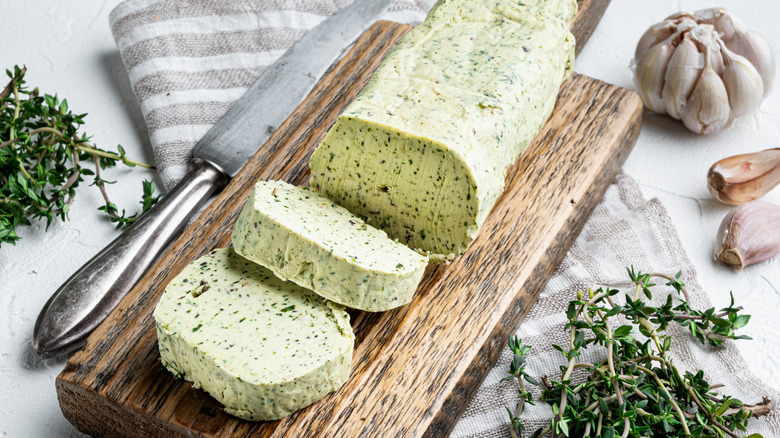How To Easily Turn Unsalted Butter Into The Salty Variety
More often than not, a recipe will call for unsalted butter. However, there are times when you do need some of the salty stuff. The good news is that you don't need to make an additional grocery trip. You can easily transform your unsalted butter into the salted variety that you need.
The flavor of different brands of butter will vary somewhat, but a good rule of thumb is to start with the addition of ¼ teaspoon of salt per ½ cup of butter — that's a standard stick of butter in the United States. Start by softening your butter to room temperature so you can easily incorporate the salt. Taste, and then adjust from there. If the recipe calls for melted butter, you don't have to wait for it to soften — just melt it on the stovetop or in the microwave and whisk in the salt.
It's always best to err on the side of caution so you do not accidentally over-salt your food. Whether you're making a baked good or main dish, keep in mind that ingredients like cheese, stock, seasoning blends, premade doughs, nut butters, and even chocolate chips can all have some additional sodium. Also, your taste buds are less perceptive of the flavors of cold foods, so once the butter is warmed up, it will taste saltier.
Opt for a fine-grained salt
To fully incorporate the salt, it's best to use some sort of fine-grained salt, like table salt or sea salt. Kosher salt can sometimes be too coarse, and you may be left with unpleasant chunks in the butter. Keep in mind that different types of salt have varying levels of sodium. For example, the brands Diamond Crystal and Morton's both make kosher salt, but Diamond Crystal is significantly less salty. If you only have a variety of salt with a coarser texture on hand, you can simply blitz it in a spice grinder, or break it down into a finer texture with a mortar and pestle.
Depending on the intended usage of the butter, the noticeable texture of salt may not necessarily be a bad thing. Say you just made fresh sourdough bread and you forgot to grab salted butter from the store. When you make your own salted butter to go with your loaf, try using flaky salt instead. The delicate crunch of the salt will be super pleasant.
Turn homemade salted butter into compound butter
The great thing about making your own salted butter is that you can control exactly how salty the resulting mixture is. This is especially useful when you want to amp up the flavor and make a compound butter. Sweet or savory, the sky's the limit when it comes to what ingredients you can add to plain old butter.
In addition to salt, add honey and fresh, finely chopped rosemary to make a compound butter for slathering onto biscuits, cornbread, or a simple piece of toast. Add fresh garlic, parmesan, and parsley to butter for delicious garlic bread. Incorporate a mixture of spices like paprika, garlic powder, onion powder, and black pepper, and melt a spoonful of this all-purpose seasoned butter into a pot of steamed white rice to seriously upgrade a humble starch.
Once you have combined butter and salt with the ingredients of your choice, you can roll it into a log using parchment paper or plastic wrap. After chilling, it will be easy to slice into coins that are perfect for topping off a seared steak or a pile of mashed potatoes. You can also simply transfer your flavored butter into a sealable container. If you used fresh ingredients, you can keep it in the fridge for up to five days, or in the freezer for around three months. Butter with just salt or shelf-stable dried spices will last months in the refrigerator, and even longer in the freezer.



